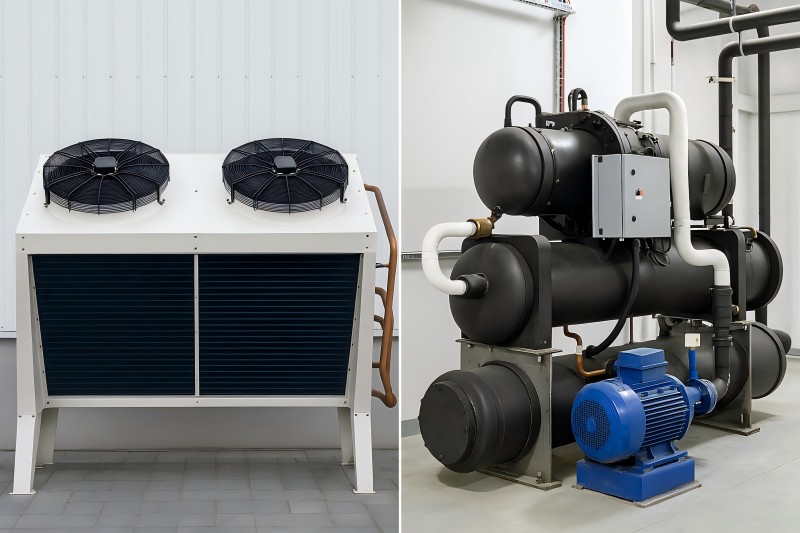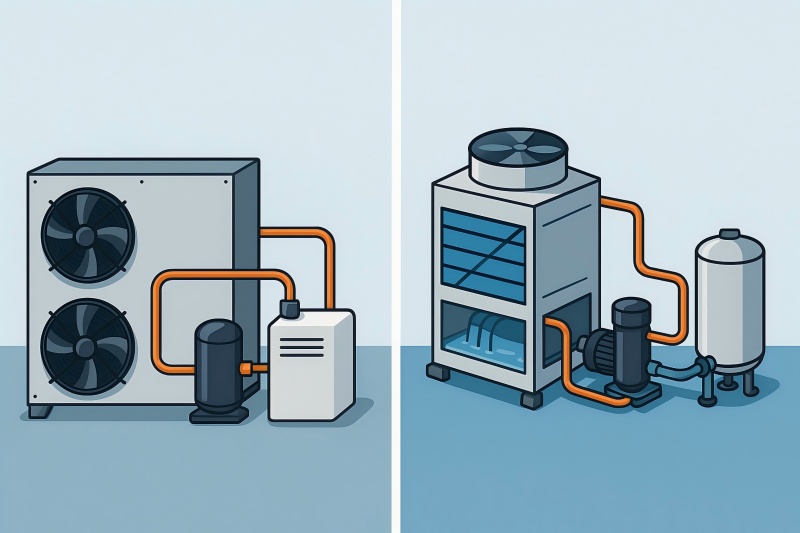Cold rooms are essential for industries ranging from food storage and pharmaceuticals to logistics and manufacturing. At the heart of every cold room lies its refrigeration system, which determines efficiency, reliability, and operating costs. One of the system’s most important parts is the condenser, tasked with removing heat from the cold room.
Manufacturers often face a crucial decision when designing or sourcing cold rooms: Should the refrigeration system use an air-cooled or water-cooled condenser? Both technologies serve the same purpose—removing heat from the refrigerant—but they differ significantly in design, efficiency, installation, and cost-effectiveness.
How Refrigeration Systems in Cold Rooms Work
A cold room refrigeration system follows the same basic vapor compression cycle used in commercial refrigeration and air conditioning:
- Evaporation – Refrigerant absorbs heat from the cold room through the evaporator coil, lowering the internal temperature.
- Compression – Compression increases the refrigerant vapor’s pressure and elevates its temperature.
- Condensation – The hot refrigerant vapor releases heat in the condenser, transforming into a liquid state.
- Expansion – The expansion valve lowers refrigerant pressure, cooling the refrigerant before it enters the evaporator.
The condenser stage is where heat rejection occurs, and this is where the choice between air-cooled and water-cooled systems comes into play.
Working Principle of Air-Cooled Condensers
Fans blow outside air over finned condenser coils, and the heat is rejected directly into the environment.
- Structure: Copper tubes with aluminum fins, fans, and casing.
- Operation: Hot refrigerant vapor flows through coils → Fans draw air over coils → Refrigerant condenses into liquid.
- Heat Rejection Medium: Air.
Key Advantages of Air-Cooled Condensers
- Lower installation cost: No cooling tower or water treatment system required.
- Simple design: Fewer moving parts and less maintenance.
- Flexibility: Easy to install in small or medium-sized cold rooms.
- Water independence: Ideal in areas with scarce or expensive water.
Limitations of Air-Cooled Condensers
- Efficiency decreases in hot climates: As ambient air temperature rises, the condenser struggles to reject heat effectively.
- Higher power consumption: Fans and compressors work harder to achieve cooling, increasing energy costs.
- Noise levels: The operation of large fans can generate significant noise in urban or sensitive areas.
Water-Cooled Condensers: Working Principle
Water-cooled condensers use water as the primary medium to absorb and reject heat. Water circulates through tubes or shell, removing refrigerant heat. The warmed water is then cooled in a cooling tower or chiller before being reused.
- Structure: Shell-and-tube or brazed plate design, circulating pump, and cooling tower.
- Operation: Refrigerant flows inside tubes or shell → Cooling water absorbs heat → Water cooled in tower → Refrigerant condenses into liquid.
- Heat Rejection Medium: Water (then air via cooling tower).
Key Advantages of Water-Cooled Condensers
- Higher efficiency: Water absorbs and transfers heat better than air, making these systems more energy-efficient.
- Stable performance: Less affected by outdoor temperature fluctuations.
- Compact condenser units: Requires less physical space inside mechanical rooms.
- Longer equipment lifespan: Lower operating pressures reduce compressor wear.
Limitations of Water-Cooled Condensers
- Higher initial cost: Cooling towers, pumps, and piping increase upfront investment.
- Water usage: Requires consistent water supply and treatment to prevent scaling or corrosion.
- Maintenance complexity: More components (tower, pump, water treatment) mean higher service requirements.
- Space requirements for cooling tower: Outdoor installation space is necessary.

Technical Comparison: Air-Cooled vs Water-Cooled Condensers
The table below summarizes key differences:
| Feature | Air-Cooled Condenser | Water-Cooled Condenser |
| Heat Rejection Medium | Ambient air | Water + cooling tower |
| Initial Cost | Lower | Higher |
| Operating Cost | Higher (more electricity) | Lower (less power per ton) |
| Efficiency | Lower in hot climates | Higher, stable performance |
| Maintenance | Simple, less frequent | Complex, requires water treatment |
| Water Requirement | None | High |
| Lifespan | 10–15 years | 15–20 years (with proper maintenance) |
| Space Requirement | Larger indoor/outdoor footprint | Compact condenser, but requires tower space |
| Noise Level | Higher (fan operation) | Lower (quiet indoors, some tower noise) |
| Best Applications | Small to medium cold rooms, dry regions | Large cold rooms, humid/hot climates, industrial settings |
Energy Consumption and Cost Analysis
Air-cooled and water-cooled systems impact operational costs differently.
- Air-Cooled Systems: Power consumption is typically 5–10% higher for the same cooling capacity compared to water-cooled. Hot environments amplify this gap, as elevated ambient air reduces condenser performance.
- Water-Cooled Systems: While they consume water and require pumps/towers, they reduce compressor power consumption significantly, leading to 15–30% energy savings over time.
Example Calculation (100 kW Cooling Load)
| System | Initial Cost Estimate | Annual Operating Cost (Energy + Water) | Payback |
| Air-Cooled | $40,000 | $20,000 | Immediate low-cost |
| Water-Cooled | $70,000 | $15,000 (incl. water) | ~6 years |
Small businesses often find the air-cooled option appealing because of its lower initial investment requirements. For large-scale facilities, the water-cooled system typically provides long-term savings.
Climate and Location Considerations
- Hot and humid regions: Water-cooled condensers outperform air-cooled units since ambient air has less cooling potential.
- Dry regions with water scarcity: Air-cooled condensers are preferable, as water use is limited or costly.
- Urban installations: Water-cooled condensers minimize noise pollution compared to large air-cooled fans.
- Remote or portable cold rooms: Air-cooled systems are easier to transport and install.
Maintenance Requirements
Air-Cooled Condensers
- Coil cleaning (dust and debris reduce efficiency).
- Fan motor inspections.
- Refrigerant pressure monitoring.
Water-Cooled Condensers
- Water treatment for scale and algae control.
- Cooling tower maintenance (fans, pumps, fill media).
- Mechanical brushing or chemical treatment to avoid fouling.
While air-cooled systems require simpler maintenance, water-cooled systems demand a proactive maintenance plan but reward with better efficiency.
Environmental Impact
- Air-Cooled Systems: Consume more electricity, potentially leading to higher carbon emissions, but conserve water.
- Water-Cooled Systems: Reduce electricity use but consume significant water, making them less suitable in regions facing drought.
Manufacturers are increasingly exploring hybrid condensers that combine the best of both worlds—air cooling with optional water spray—to balance energy efficiency and water usage.
Applications by Industry
- Food Industry: Water-cooled systems favored for large cold storage warehouses. Air-cooled systems work well for restaurants, supermarkets, and small processors.
- Pharmaceuticals: Water-cooled condensers ensure stable temperatures critical for vaccine and medicine storage.
- Logistics & Warehousing: Large distribution centers prefer water-cooled for efficiency. Smaller logistics hubs may use air-cooled.
- Meat & Seafood Processing: Water-cooled systems provide strong, stable cooling even in high ambient environments.
Manufacturer’s Perspective: Helping Clients Choose
As a cold room manufacturer, our role extends beyond equipment supply—we provide tailored solutions based on:
- Load calculations (capacity, insulation, and product turnover).
- Geographic factors (climate, water availability, energy tariffs).
- Budget and ROI goals (initial investment vs operating cost).
- Sustainability targets (energy efficiency vs water conservation).
Our design teams evaluate whether air-cooled or water-cooled condensers best fit the project, ensuring long-term efficiency, reliability, and compliance with international refrigeration standards.
When comparing air-cooled vs water-cooled condensers for cold rooms, the choice depends on project scale, location, and long-term cost strategy.
- Air-Cooled Condensers: Best for small to medium cold rooms, water-scarce regions, and businesses prioritizing lower upfront costs and simpler maintenance.
- Water-Cooled Condensers: Best for large-scale cold rooms, hot or humid climates, and facilities seeking long-term energy savings and stable performance.
As a cold room manufacturer, we emphasize that the right refrigeration system is not one-size-fits-all. A professional evaluation ensures businesses achieve the perfect balance of efficiency, cost-effectiveness, and reliability for their cold storage operations.

